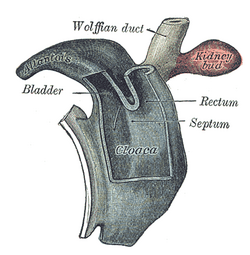

| Urorectal septum | |
|---|---|

Cloaca of human embryo from twenty-five to twenty-seven days old.
| |
| Details | |
| Days | 32 |
| Identifiers | |
| Latin | septum urorectale |
| TE | septum_by_E5.4.9.0.2.0.14 E5.4.9.0.2.0.14 |
| Anatomical terminology | |
The endodermal cloaca is divided into a dorsal and a ventral part by means of a partition, the urorectal septum, which grows downward from the ridge separating the allantois from the cloacal opening of the intestine and ultimately fuses with the cloacal membrane and divides it into an anal and a urogenital part. The dorsal part of the cloaca forms the rectum, and the anterior part of the urogenital sinus and bladder. The urorectal septum eventually becomes part of the perineal body.
Malformation of the urorectal septum can lead to several different types of fistulas.[1]
![]() This article incorporates text in the public domain from page 1109 of the 20th edition of Gray's Anatomy (1918)
This article incorporates text in the public domain from page 1109 of the 20th edition of Gray's Anatomy (1918)
This anatomy article is a stub. You can help Wikipedia by expanding it. |